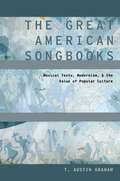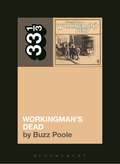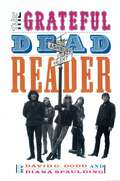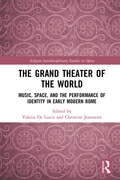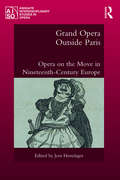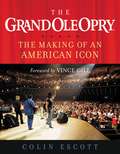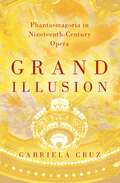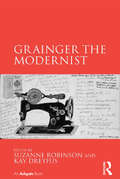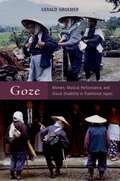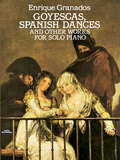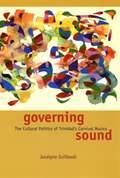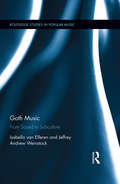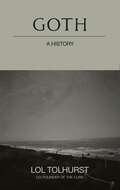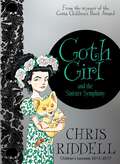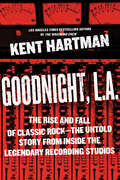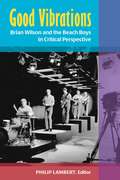- Table View
- List View
The Great American Songbooks: Musical Texts, Modernism, and the Value of Popular Culture (Modernist Literature and Culture)
by T. Austin GrahamIn the late nineteenth and early twentieth centuries, American authors pioneered a mode of musical writing that quite literally resounded beyond the printed page. Novels gained soundtracks, poetry compelled its audiences to sing, and the ostensibly silent act of reading became anything but. The Great American Songbooks is the story of this literature, at once an overview of musical and authorial practice at the century's turn, an investigation into the sensory dimensions of reading, and a meditation on the effects that the popular arts have had on literary modernism. The writings of John Dos Passos, Theodore Dreiser, T.S. Eliot, F. Scott Fitzgerald, Langston Hughes, Jean Toomer, and Walt Whitman are heard in a new key; the performers and tunesmiths who inspired them have their stories told; and the music of the past, long out of print and fashion, is recapitulated and made available in digital form. A work of criticism situated at the crossroads of literary analysis, musicology, and cultural history, The Great American Songbooks demonstrates the importance of studying fiction and poetry from interdisciplinary perspectives, and it suggests new avenues for research in the dawning age of the digital humanities.
Grateful Dead's Workingman's Dead (33 1/3)
by Buzz PooleReleased in 1970, Workingman's Dead was the breakthrough album for the Grateful Dead, a cold-water-shock departure from the Acid Test madness of the late '60s. It was the band's most commercially and critically successful release to date. More importantly, these songs established the blueprint for how the Dead would maintain and build upon a community held together by the core motivation of rejecting the status quo – the "straight life†? – in order to live and work on their own terms. As a unified whole, the album's eight songs serve as points of entry into a fully-rendered portrait of the Grateful Dead within the context of late twentieth-century American history. These songs speak to the attendant cultural and political anxieties that resulted from the idealism of the '60s giving way to the uncomfortable realities of the '70s, and the band's evolving perspective on these changes. Based on research, interviews, and personal experience, this book probes the paradox at the heart of the band's appeal: the Grateful Dead were about much more than music, though they were really just about the music.
Grateful Dead's Workingman's Dead (33 1/3)
by Buzz PooleReleased in 1970, Workingman's Dead was the breakthrough album for the Grateful Dead, a cold-water-shock departure from the Acid Test madness of the late '60s. It was the band's most commercially and critically successful release to date. More importantly, these songs established the blueprint for how the Dead would maintain and build upon a community held together by the core motivation of rejecting the status quo – the “straight life” – in order to live and work on their own terms. As a unified whole, the album's eight songs serve as points of entry into a fully-rendered portrait of the Grateful Dead within the context of late twentieth-century American history. These songs speak to the attendant cultural and political anxieties that resulted from the idealism of the '60s giving way to the uncomfortable realities of the '70s, and the band's evolving perspective on these changes. Based on research, interviews, and personal experience, this book probes the paradox at the heart of the band's appeal: the Grateful Dead were about much more than music, though they were really just about the music.
The Grateful Dead Reader (Readers on American Musicians)
Arranged in chronological order, these pieces add up to nothing less than a full-scale history of the greatest tour band in the history of rock. From Tom Wolfe's account of the Dead's first performance as the Grateful Dead (at an Acid Test in 1965), to Ralph Gleason's 1967 interview with the 24-year-old Jerry Garcia, to Mary Eisenhart's obituary of the beloved leader of the band, these selections include not only outstanding writing on the band itself, but also superb pieces on music and pop culture generally. Fans will be fascinated by the poetry, fiction, drawings, and rare and revealing photographs featured in the book, as well as the anthology's many interviews and profiles, interpretations of lyrics, and concert and record reviews. Still, The Grateful Dead was more than a band--it was a cultural phenomenon. For three decades it remained on one unending tour, followed everywhere by a small army of nomadic fans. This phenomenon is both analyzed and celebrated here, in such pieces as Ed McClanahan's groundbreaking article in Playboy in 1972, fan-magazine editor Blair Jackson's 1990 essay on the seriousness of the drug situation at Dead concerts, and Steve Silberman's insightful essays on the music and its fans.
Granville Bantock: A Guide to Research (Clemson University Press)
by John C. DresslerThe book will contain location and descriptive details of Bantock's manuscripts that are extant, which will assist those looking to construct editions of those works which have remained in manuscript and updated editions of those works which were initially published nearly 100 years ago. A discography provides insight into the wide variety of recording companies that first served Bantock’s music. It also includes more recent and more highly refined recording sonics that help listeners hear these works in a much more solid balance and quality of sound than the multitude of 78 rpm recordings which form the initial recordings of any of Bantock’s pieces. Included in the book are sections which highlight academic theses and dissertations that discuss some of Bantock’s works. In addition citations of locations of many of Bantock’s letters still available for study are included. An index that cross-references all of these details to the works which they highlight is a major help to the reader.
The Grand Theater of the World: Music, Space, and the Performance of Identity in Early Modern Rome (Ashgate Interdisciplinary Studies in Opera)
by Valeria De Lucca Christine JeanneretMusic and space in the early modern world shaped each other in profound ways, and this is particularly apparent when considering Rome, a city that defined itself as the "grande teatro del mondo". The aim of this book is to consider music and space as fundamental elements in the performance of identity in early modern Rome. Rome’s unique milieu, as defined by spiritual and political power, as well as diplomacy and competition between aristocratic families, offers an exceptionally wide array of musical spaces and practices to be explored from an interdisciplinary perspective. Space is viewed as the theatrical backdrop against which to study a variety of musical practices in their functions as signifiers of social and political meanings. The editors wish to go beyond the traditional distinction between music theatrical spectacles – namely opera – and other musical genres and practices to offer a more comprehensive perspective on the ways in which not only dramatic, but also instrumental music and even the sounds of voices and objects in the streets relied on the theatrical dimension of space for their effectiveness in conveying social and political messages. While most chapters deal with musical performances, some focus on specific aspects of the Roman soundscape, or are even intentionally "silent", dealing with visual arts and architecture in their performative and theatrical aspects. The latter offer a perspective that creates a visual counterpoint to the ways in which music and sound shaped space.
The Grand Theater of the World: Music, Space, and the Performance of Identity in Early Modern Rome (Ashgate Interdisciplinary Studies in Opera)
by Valeria De Lucca Christine JeanneretMusic and space in the early modern world shaped each other in profound ways, and this is particularly apparent when considering Rome, a city that defined itself as the "grande teatro del mondo". The aim of this book is to consider music and space as fundamental elements in the performance of identity in early modern Rome. Rome’s unique milieu, as defined by spiritual and political power, as well as diplomacy and competition between aristocratic families, offers an exceptionally wide array of musical spaces and practices to be explored from an interdisciplinary perspective. Space is viewed as the theatrical backdrop against which to study a variety of musical practices in their functions as signifiers of social and political meanings. The editors wish to go beyond the traditional distinction between music theatrical spectacles – namely opera – and other musical genres and practices to offer a more comprehensive perspective on the ways in which not only dramatic, but also instrumental music and even the sounds of voices and objects in the streets relied on the theatrical dimension of space for their effectiveness in conveying social and political messages. While most chapters deal with musical performances, some focus on specific aspects of the Roman soundscape, or are even intentionally "silent", dealing with visual arts and architecture in their performative and theatrical aspects. The latter offer a perspective that creates a visual counterpoint to the ways in which music and sound shaped space.
Grand Opera Outside Paris: Opera on the Move in Nineteenth-Century Europe (Ashgate Interdisciplinary Studies in Opera)
by Jens HesselagerNineteenth-century French grand opera was a musical and cultural phenomenon with an important and widespread transnational presence in Europe. Primary attention in the major studies of the genre has so far been on the Parisian context for which the majority of the works were originally written. In contrast, this volume takes account of a larger geographical and historical context, bringing the Europe-wide impact of the genre into focus. The book presents case studies including analyses of grand opera in small-town Germany and Switzerland; grand operas adapted for Scandinavian capitals, a cockney audience in London, and a court audience in Weimar; and Portuguese and Russian grand operas after the French model. Its overarching aim is to reveal how grand operas were used – performed, transformed, enjoyed and criticised, emulated and parodied – and how they became part of musical, cultural and political life in various European settings. The picture that emerges is complex and diversified, yet it also testifies to the interrelated processes of cultural and political change as bourgeois audiences, at varying paces and with local variations, increased their influence, and as discourses on language, nation and nationalism influenced public debates in powerful ways.
Grand Opera Outside Paris: Opera on the Move in Nineteenth-Century Europe (Ashgate Interdisciplinary Studies in Opera)
by Jens HesselagerNineteenth-century French grand opera was a musical and cultural phenomenon with an important and widespread transnational presence in Europe. Primary attention in the major studies of the genre has so far been on the Parisian context for which the majority of the works were originally written. In contrast, this volume takes account of a larger geographical and historical context, bringing the Europe-wide impact of the genre into focus. The book presents case studies including analyses of grand opera in small-town Germany and Switzerland; grand operas adapted for Scandinavian capitals, a cockney audience in London, and a court audience in Weimar; and Portuguese and Russian grand operas after the French model. Its overarching aim is to reveal how grand operas were used – performed, transformed, enjoyed and criticised, emulated and parodied – and how they became part of musical, cultural and political life in various European settings. The picture that emerges is complex and diversified, yet it also testifies to the interrelated processes of cultural and political change as bourgeois audiences, at varying paces and with local variations, increased their influence, and as discourses on language, nation and nationalism influenced public debates in powerful ways.
The Grand Ole Opry: The Making of an American Icon
by Colin EscottThis official guide chronicles the story of the birthplace of country music as told by the people who were there. Escott presents the official inside history of the home of country music, offering fans an exclusive look into the heart and soul of country music. Full color, and packed with photos from the Opry Archives covering 80 years of history.
Grand Illusion: Phantasmagoria in Nineteenth-Century Opera
by Gabriela CruzA new and groundbreaking approach to the history of grand opera, Grand Illusion: Phantasmagoria in Nineteenth-Century Opera explores the illusion and illumination behind the form's rise to cultural eminence. Renowned opera scholar Gabriela Cruz argues that grand opera worked to awaken memory and feeling in a way never before experienced in the opera house, asserting that the concept of "spectacle" was the defining cultural apparatus of the art form after the 1820s. Parisian audiences at the Académie Royale de Musique were struck by the novelty and power of grand opera upon the introduction of gaslight illumination, a technological innovation that quickly influenced productions across the Western operatic world. With this innovation, grand opera transformed into an audio-visual spectacle, delivering dream-like images and evoking the ghosts of its audiences' past. Through case studies of operas by Giacomo Meyerbeer, Richard Wagner, and Giuseppe Verdi, Cruz demonstrates how these works became an increasingly sophisticated medium by which audiences could conjure up the past and be transported away from the breakdown of modern life. A historically informed narrative that traverses far and wide, from dingy popular theatres in post-revolutionary Paris, to nautical shows in London, and finally to Egyptian mummies, Grand Illusion provides a fresh departure from previous scholarship, highlighting the often-neglected visual side of grand opera.
Grand Illusion: Phantasmagoria in Nineteenth-Century Opera
by Gabriela CruzA new and groundbreaking approach to the history of grand opera, Grand Illusion: Phantasmagoria in Nineteenth-Century Opera explores the illusion and illumination behind the form's rise to cultural eminence. Renowned opera scholar Gabriela Cruz argues that grand opera worked to awaken memory and feeling in a way never before experienced in the opera house, asserting that the concept of "spectacle" was the defining cultural apparatus of the art form after the 1820s. Parisian audiences at the Académie Royale de Musique were struck by the novelty and power of grand opera upon the introduction of gaslight illumination, a technological innovation that quickly influenced productions across the Western operatic world. With this innovation, grand opera transformed into an audio-visual spectacle, delivering dream-like images and evoking the ghosts of its audiences' past. Through case studies of operas by Giacomo Meyerbeer, Richard Wagner, and Giuseppe Verdi, Cruz demonstrates how these works became an increasingly sophisticated medium by which audiences could conjure up the past and be transported away from the breakdown of modern life. A historically informed narrative that traverses far and wide, from dingy popular theatres in post-revolutionary Paris, to nautical shows in London, and finally to Egyptian mummies, Grand Illusion provides a fresh departure from previous scholarship, highlighting the often-neglected visual side of grand opera.
Grainger the Modernist
by Suzanne Robinson Kay DreyfusUnaccountably, Percy Grainger has remained on the margins of both American music history and twentieth-century modernism. This volume reveals the well-known composer of popular gems to be a self-described ’hyper-modernist’ who composed works of uncompromising dissonance, challenged the conventions of folk song collection and adaptation, re-visioned the modern orchestra, experimented with ’ego-less’ composition and designed electronic machines intended to supersede human application. Grainger was far from being a self-sufficient maverick working in isolation. Through contact with innovators such as Ferrucio Busoni, Léon Theremin and Henry Cowell; promotion of the music of modern French and Spanish schools; appreciation of vernacular, jazz and folk musics; as well as with the study and transcription of non-Western music; he contested received ideas and proposed many radical new approaches. By reappraising Grainger’s social and historical connectedness and exploring the variety of aspects of modernity seen in his activities in the British, American and Australian contexts, the authors create a profile of a composer, propagandist and visionary whose modernist aesthetic paralleled that of the most advanced composers of his day, and, in some cases, anticipated their practical experiments.
Grainger the Modernist
by Suzanne Robinson Kay DreyfusUnaccountably, Percy Grainger has remained on the margins of both American music history and twentieth-century modernism. This volume reveals the well-known composer of popular gems to be a self-described ’hyper-modernist’ who composed works of uncompromising dissonance, challenged the conventions of folk song collection and adaptation, re-visioned the modern orchestra, experimented with ’ego-less’ composition and designed electronic machines intended to supersede human application. Grainger was far from being a self-sufficient maverick working in isolation. Through contact with innovators such as Ferrucio Busoni, Léon Theremin and Henry Cowell; promotion of the music of modern French and Spanish schools; appreciation of vernacular, jazz and folk musics; as well as with the study and transcription of non-Western music; he contested received ideas and proposed many radical new approaches. By reappraising Grainger’s social and historical connectedness and exploring the variety of aspects of modernity seen in his activities in the British, American and Australian contexts, the authors create a profile of a composer, propagandist and visionary whose modernist aesthetic paralleled that of the most advanced composers of his day, and, in some cases, anticipated their practical experiments.
GOZE WOM, MUS PERF & VIS DIS TRAD JAP C: Women, Musical Performance, and Visual Disability in Traditional Japan
by Gerald GroemerIn a tradition extending from the medieval era to the early twentieth century, visually disabled Japanese women known as goze toured the countryside as professional singers. An integral part of rural musical culture, the goze sang unique narratives of their own making and a significant repertory of popular ballads and short songs. Goze activities peaked in the nineteenth century, and some women continued to tour well into the middle of the twentieth. The last active goze lived until 2005. In Goze: Women, Musical Performance, and Visual Disability in Traditional Japan, Gerald Groemer examines the way of life, institutions, and songs of these itinerant performers. Groemer shows that the solidarity and success goze achieved with the rural public through narrative and music was based on the convergence of the goze's desire for a degree of social and economic autonomy with the audience's wish to mitigate the cultural deprivation it so often experienced. Goze recognized audiences as a stimulus for developing repertories and careers; the public in turn recognized goze as masterful artisans who acted as powerful agents of widespread cultural development. As the first full-length scholarly work on goze in English, this book is an invaluable resource to scholars and students of Japanese culture, Japanese music, ethnomusicology, and disability studies worldwide.
Goze: Women, Musical Performance, and Visual Disability in Traditional Japan
by Gerald GroemerIn a tradition extending from the medieval era to the early twentieth century, visually disabled Japanese women known as goze toured the countryside as professional singers. An integral part of rural musical culture, the goze sang unique narratives of their own making and a significant repertory of popular ballads and short songs. Goze activities peaked in the nineteenth century, and some women continued to tour well into the middle of the twentieth. The last active goze lived until 2005. In Goze: Women, Musical Performance, and Visual Disability in Traditional Japan, Gerald Groemer examines the way of life, institutions, and songs of these itinerant performers. Groemer shows that the solidarity and success goze achieved with the rural public through narrative and music was based on the convergence of the goze's desire for a degree of social and economic autonomy with the audience's wish to mitigate the cultural deprivation it so often experienced. Goze recognized audiences as a stimulus for developing repertories and careers; the public in turn recognized goze as masterful artisans who acted as powerful agents of widespread cultural development. As the first full-length scholarly work on goze in English, this book is an invaluable resource to scholars and students of Japanese culture, Japanese music, ethnomusicology, and disability studies worldwide.
Goyescas, Spanish Dances and Other Works for Solo Piano
by Enrique GranadosThis remarkable book brings together in one sturdy, yet inexpensive volume four of the most memorable and frequently played sets of works for the piano by Enrique Granados (1867-1916), one of Spain's greatest modern composers. They are reprinted here from early editions.The piano suite Goyescas, first performed in Barcelona in 1911, would bring Granados his greatest, most enduring success. In each of its six pieces, the composer employs wild, insistent melody and highly individual rhythm, harmony, and coloring to create dramatic impressions of paintings by Goya, to whose work Granados was deeply drawn.The exquisite Spanish Dances, a suite of early works, were much admired by the leading composers of the day, among them Massenet, Saint-Saëns, and Grieg, not only for their distinctive musical qualities, but also for the new direction in Spanish music which they heralded. They remain today perhaps the most performed of Granados's work.Less well known in America are the beautiful Escenas poéticas and Escenas románticas, two suites which reflect Granados's interest in the music of Grieg, Schumann, and Liszt, yet are filled with the great Spanish composer's original modulations and characteristic melodic writing. Together, the four suites offer performing artists, teachers, students, and music lovers a rich treasury of the finest and most enduring of Granados's compositions for the piano.
Governing Sound: The Cultural Politics of Trinidad's Carnival Musics (Chicago Studies in Ethnomusicology)
by Jocelyne GuilbaultCalypso music is an integral part of Trinidad’s national identity. When, for instance, Franklin D. Roosevelt asked the great Trinidadian musician Roaring Lion where he was from, Lion famously replied “the land of calypso.” But in a nation as diverse as Trinidad, why is it that calypso has emerged as the emblematic music? In Governing Sound, Jocelyne Guilbault examines the conditions that have enabled calypso to be valorized, contested, and targeted as a field of cultural politics in Trinidad. The prominence of calypso, Guilbault argues, is uniquely enmeshed in projects of governing and in competing imaginations of nation, race, and diaspora. During the colonial regime, the period of national independence, and recent decades of neoliberal transformation, calypso and its musical offshoots have enabled new cultural formations while simultaneously excluding specific social expressions, political articulations, and artistic traditions. Drawing on over a decade of ethnographic work, Guilbault maps the musical journeys of Trinidad’s most prominent musicians and arrangers and explains the distinct ways their musical sensibilities became audibly entangled with modes of governing, audience demands, and market incentives. Generously illustrated and complete with an accompanying CD, Governing Sound constitutes the most comprehensive study to date of Trinidad’s carnival musics.
Goth Music: From Sound to Subculture (Routledge Studies in Popular Music)
by Isabella van Elferen Jeffrey Andrew WeinstockIs "goth music" a genre, and if so, how does it relate to the goth subculture? The music played at goth club nights and festivals encompasses a broad range of musical substyles, from gloomy Batcave reverberations to neo-medieval bagpipe drones and from the lush vocals of goth metal to the harsh distortion of goth industrial. Goth Music: From Sound to Subculture argues that within this variegated musical landscape a number of key consistencies exist. Not only do all these goth substyles share a number of musical and textual characteristics, but more importantly these aspects of the music are constitutive of goth social reality. Drawing on their own experiences in the European and American goth scenes, the authors explore the ways in which the sounds of goth inform the scene’s listening practices, its fantasies of other worlds, and its re-enchantment of their own world. Goth music, this book asserts, engenders a musical timespace of its own, a musical chronotope that is driven by nostalgic yearning. Goth Music: From Sound to Subculture reorients goth subcultural studies onto music: goth music must be recognized not only as simultaneously diverse and consistent, but also as the glue that holds together goth scenes from all over the world. It all starts with the music.
Goth Music: From Sound to Subculture (Routledge Studies in Popular Music)
by Isabella van Elferen Jeffrey Andrew WeinstockIs "goth music" a genre, and if so, how does it relate to the goth subculture? The music played at goth club nights and festivals encompasses a broad range of musical substyles, from gloomy Batcave reverberations to neo-medieval bagpipe drones and from the lush vocals of goth metal to the harsh distortion of goth industrial. Goth Music: From Sound to Subculture argues that within this variegated musical landscape a number of key consistencies exist. Not only do all these goth substyles share a number of musical and textual characteristics, but more importantly these aspects of the music are constitutive of goth social reality. Drawing on their own experiences in the European and American goth scenes, the authors explore the ways in which the sounds of goth inform the scene’s listening practices, its fantasies of other worlds, and its re-enchantment of their own world. Goth music, this book asserts, engenders a musical timespace of its own, a musical chronotope that is driven by nostalgic yearning. Goth Music: From Sound to Subculture reorients goth subcultural studies onto music: goth music must be recognized not only as simultaneously diverse and consistent, but also as the glue that holds together goth scenes from all over the world. It all starts with the music.
Goth: A History
by Lol TolhurstGOTH is an entertaining and engaging historical memoir of the genre of Goth music and culture, exploring creative giants like The Cure, Siouxsie and the Banshees, Bauhaus, Joy Division and many more great bands that offered a place of refuge for the misfits of the 80s and ever since. Written by Lol Tolhurst, co-founder of The Cure, this book offers a fascinating deep dive into the movers and shakers of goth with stories and anecdotes from Tolhurst's personal memories as well as the musicians, magicians and artists who made it all happen - the people, places and events that made goth an inevitable and enduring movement . Starting with the Origins of Goth, Tolhurst explores early art and literature that inspired the genre and looks into the work of T.S Eliot, Edgar Allan Poe, Sylvia Plath, Albert Camus and more. He also outlines the path of Gothic forebears and shows how many musicians played in punk bands before transitioning into goth endeavours. Next, he introduces readers to the 'Architects of Darkness' - Bauhaus, Siouxsie and the Banshees, Joy Division and The Cure - the godfathers of goth who established the genre's roots. Following these early bands, Tolhurst discusses a group he calls the 'Spiritual Alchemists', consisting of bands like Depeche Mode, Cocteau Twins and more, who helped the darkness expand into the culture. He also tracks the expansion of the genre overseas, from England to New York, Los Angeles and beyond. Gothic fashion was an important part of the movement as well and Tolhurst discusses the clothing that accompanied and complemented the music. Finally, Tolhurst examines the legacy of goth music and shows how its influence can still be seen to this day across music, film, TV, visual arts, social media and so much more, finally concluding with 'Why Goth matters!'
Goth Girl and the Sinister Symphony (Goth Girl #4)
by Chris RiddellThere are musical goings-on and a mystery for Ada to solve in Goth Girl and the Sinister Symphony, the fourth beautifully illustrated adventure in the series from Chris Riddell, 2015–2017 Children's Laureate and author of the Ottoline books.Lord Goth is throwing a music festival at Ghastly-Gorm Hall, with performances from the finest composers in the land. Ada can't wait, but it's quite distracting when her grandmother is trying to find her father a fashionable new wife. And there's a faun living in her wardrobe. Worst of all, Maltravers is up to his old tricks and Ada must make sure everything goes to plan. Luckily, help is at hand – from a very interesting house guest . . .For more in the deliciously dark series, check out the first book and winner of the Costa Children's Book Award, Goth Girl and the Ghost of a Mouse.
Goodnight, L.A.: The Rise and Fall of Classic Rock--The Untold Story from inside the Legendary Recording Studios
by Kent HartmanA behind-the-scenes journey through the rise and demise of the '70s and '80s classic rock eraBefore disco, punk, hair metal, rap, and eventually grunge took it all away, the music scene in Los Angeles was dominated by rock 'n' roll. If a group wanted to hit it big, L.A. was the place to be. But in addition to the bands themselves finding their footing, their albums also needed some guidance. That came from a group of dedicated producers and engineers working in a cadre of often dilapidated-looking buildings that contained some of the greatest recording studios the music industry has ever known.Within the windowless walls of these well-hidden studios, legends-to-be such as Foreigner, Fleetwood Mac, Pat Benatar, Boston, the Eagles, the Grateful Dead, Chicago, Linda Ronstadt, Santana, Tom Petty and the Heartbreakers, Loggins and Messina, REO Speedwagon, and dozens more secretly created their album masterpieces: Double Vision. Rumours. Hotel California. Terrapin Station. Damn the Torpedoes. Hi Infidelity. However, the truth of what went on during these recording sessions has always remained elusive. But not anymore.Longtime music-business insider Kent Hartman has filled Goodnight, L.A. with troves of never-before-told stories about the most prolific and important period and place in rock 'n' roll history. With music producer Keith Olsen and guitarist Waddy Wachtel as guides to the journey and informed by new, in-depth interviews with classic rock artists, famed record producers, and scores of others, Goodnight, L.A. reveals what went into the making of some of the best music of the past forty years. Readers will hear how some of their favorite albums and bands came to be, and ultimately how fame, fortune, excess, and a shift in listener demand brought it all tumbling down.
Good Vibrations: Brian Wilson and the Beach Boys in Critical Perspective (Tracking Pop)
by Philip LambertGood Vibrations brings together scholars with a variety of expertise, from music to cultural studies to literature, to assess the full extent of the contributions to popular culture and popular music of one the most successful and influential pop bands of the twentieth century. The book covers the full fifty-year history of the Beach Boys’ music, from essays on some of the group’s best-known music—such as their hit single “Good Vibrations” —to their mythical unfinished masterpiece, Smile. Throughout, the book places special focus on the individual whose creative vision brought the whole enterprise to life, Brian Wilson, advancing our understanding of his gifts as a songwriter, arranger, and producer. The book joins a growing body of literature on the popular music of the 1960s, in general, and on Brian Wilson and the Beach Boys in particular. But Good Vibrations extends the investigation further and deeper than it has gone before, not only offering new understanding and insights into individual songs and albums, but also providing close examination of compositional techniques and reflections on the group’s place in American popular culture.
Good Vibrations: My Life as a Beach Boy
by Mike LoveMike Love is a founding member, lyricist and vocalist of The Beach Boys, considered to be the most popular American band in history, with 13 Gold Albums, 55 top-100 singles, and four #1 hits. Love has been the lead singer of the group one of its principal lyricists since its inception in 1961.In Good Vibrations, Mike Love tells the unique story of his legendary, chaotic, and ultimately triumphant five-decade tenure as the front man of The Beach Boys, from their Californian roots to international fame.Mike Love's credits include such pop classics as "Good Vibrations," "California Girls," "I Get Around," "Fun Fun Fun," and "Kokomo."
